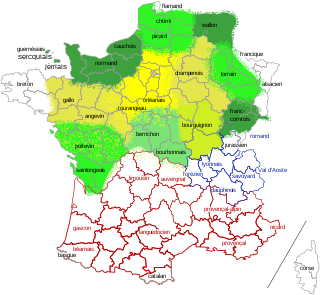Bahasa Walonia
Walloon (/wɒˈluːn/; natively walon; bahasa Prancis: wallon) is a Romance language that is spoken in much of Wallonia and, to a very small extent, in Brussels, Belgium; some villages near Givet, northern France; and a clutch of communities in northeastern Wisconsin, U.S.[8]
It belongs to the langues d'oïl language family, the most prominent member of which is French. The historical background of its formation was the territorial extension since 980 of the Principality of Liège to the south and west. Walloon is classified as "definitely endangered" by the UNESCO Atlas of the World's Languages in Danger.[9]
Despite its rich literature, beginning anonymously in the 16th century and with well-known authors since 1756, the use of Walloon has decreased markedly since France's annexation of Wallonia in 1794. This period definitively established French as the language of social promotion, far more than it was before.[10] After World War I, public schools provided French-speaking education to all children, inducing a denigration of Walloon, especially when accompanied by official orders in 1952 to punish its use in schools. Subsequently, since the middle of the 20th century, generational transmission of the language has decreased, resulting in Walloon almost becoming a dead language. Today it is scarcely spoken among younger people, with the vast majority of its native speakers being the elderly (aged 65 and over). In 2007, the number of people with knowledge of the language was estimated at 600,000.[1]
Numerous associations, especially theatre companies, are working to keep the language alive. Formally recognized as a langue régionale endogène (regional indigenous language) of Belgium since 1990,[11] Walloon has also benefited from a continued corpus planning process. The "Feller system" (1900) regularized transcription of the different accents. Since the 1990s, a common orthography was established (the Rifondou walon), which allowed large-scale publications, such as the Walloon Wikipedia officially in 2003. In 2004, a Walloon translation of a Tintin comic was released under the name L'èmerôde d'al Castafiore; in 2007 an album consisting of Gaston Lagaffe comic strips was published in Walloon.
Walloon is more distinct as a language than Belgian French, which differs from the French spoken in France only in some minor points of vocabulary and pronunciation.
Lihat pula
- Orang Wallonia – penduduk
- Wallonia – daerah
- N – Bahasa Prancis yang dituturkan di Belgia
- Doncols; Sonlez: bekas desa penutur bahasa Walloon di Luksemburg.
Pranala luar
- Web page of Common Written Walloon
- Comprehensive grammar of Walloon Diarsipkan 2005-12-17 di Wayback Machine. (in French and under GFDL)
- phonetic system of Walloon Diarsipkan 2006-04-27 di Wayback Machine.
- Walloon language wiki
- Wallon-English Gastronomy Dictionary Diarsipkan 2005-10-12 di Wayback Machine.
- Union Culturelle Wallonne Diarsipkan 2007-02-19 di Wayback Machine.
- Ethnologue report for Walloon
- L'Arsouye, cyber-gazette wallonne
- online dictionary Diarsipkan 2011-05-22 di Wayback Machine.
- ^ a b "Europe and North Asia" (211-282) . Tapani Salminen (2007), C. Moseley · London & New York: Routledge
- ^ Walon di Ethnologue (ed. ke-18, 2015)
- ^ Hammarström, Harald; Forkel, Robert; Haspelmath, Martin; Bank, Sebastian (2022-05-24). "Oil". Glottolog. Max Planck Institute for Evolutionary Anthropology. Diarsipkan dari versi asli tanggal 2022-10-08. Diakses tanggal 2022-10-07.
- ^ Hammarström, Harald; Forkel, Robert; Haspelmath, Martin, ed. (2023). "Walloon". Glottolog 4.8. Jena, Jerman: Max Planck Institute for the Science of Human History.
- ^ "UNESCO Interactive Atlas of the World's Languages in Danger" (dalam bahasa bahasa Inggris, Prancis, Spanyol, Rusia, and Tionghoa). UNESCO. 2011. Diarsipkan dari versi asli tanggal 29 April 2022. Diakses tanggal 26 Juni 2011.
- ^ "UNESCO Atlas of the World's Languages in Danger" (PDF) (dalam bahasa Inggris). UNESCO. 2010. Diarsipkan dari versi asli (PDF) tanggal 31 Mei 2022. Diakses tanggal 31 Mei 2022.
- ^ "Bahasa Walonia". www.ethnologue.com (dalam bahasa Inggris). SIL Ethnologue.
- ^ Université du Wisconsin : collection de documents sur l'immigration wallonne au Wisconsin, enregistrements de témoignages oraux en anglais et wallon, 1976 (dalam bahasa Inggris) University of Wisconsin Digital Collection : Belgian-American Research Collection
- ^ "Endangered languages: the full list". TheGuardian.com. 15 April 2011.
- ^ "It seems the revolutionaries themselves consider the fact French was enough close to the Walloon language so as not to manage Wallonia as Brittany, Corsica, Alsace or Flanders." (dalam bahasa Prancis) "Le décret du 8 pluviôse An II (...) ne prévoit pas d'envoyer des instituteurs dans la Wallonie romane (contre l'avis de Grégoire qui souhaitait une campagne linguistique couvrant tout le territoire). Les révolutionnaires eux-mêmes semblent donc considérer que la proximité entre le français et le wallon est suffisamment grande pour ne pas traiter la Wallonie comme la Bretagne, la Corse, l'Alsace ou la Flandre." (dalam bahasa Prancis) Astrid Von Busekist, Politique des langues et construction de l'État, Éd. Duculot, Gembloux, 1998, pp. 22–28
- ^ Décret Valmy Féaux, 14 December 1990


